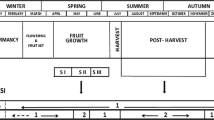Abstract.
Theoretical and experimental aspects of developing irrigation scheduling strategies using continuous measurements of trunk diameter are presented. The behavior of parameters derived from trunk diameter measurements (TDM), including maximum daily trunk shrinkage (MDS), maximum daily trunk diameter (MXTD), and minimum daily trunk diameter (MNTD) is evaluated for both rapidly growing peach [Prunus persica (L.) Batsch, cv. September Snow] and mature almond [Prunus dulcis (Mill.) Webb cv. Price] trees subjected to mild deficit irrigation. Stem water potential (SWP) and MDS were highly correlated in the mature almond trees but a poor relationship was found in the rapidly growing peach trees. Conversely, daily changes in MXTD and MNTD correlated well with SWP in the fast growing trees. While there was relatively high variability ("noise") in the MDS measurements (CV 15.8%), the greater changes in the magnitude of the MDS ("signal") resulted in a significantly higher signal:noise ratio than found with the SWP measurements. In addition to soil water and trunk growth rate, MDS patterns were influenced by irrigation frequency and evaporative demand. Based on the experimental results, protocols for utilizing the trunk diameter-derived indicators for scheduling irrigations are presented for three cases: (1) mature trees under low frequency irrigation, (2) mature trees under high frequency irrigation, and (3) young trees under high frequency irrigation. The scheduling protocols provide guidelines that address both under- and over-irrigation and are predicated on the sensitivity of TDM to very mild plant water deficits. The necessity for and approaches to developing reference (baseline) and threshold values derived from TDM are emphasized. We conclude that protocols using TDM for precise irrigation scheduling hold promise as an additional tool for progressive growers who want to link irrigation management to an automated, electronic, plant-based stress indicator.
Similar content being viewed by others

Author information
Authors and Affiliations
Additional information
Electronic Publication
Rights and permissions
About this article
Cite this article
Goldhamer, D.A., Fereres, E. Irrigation scheduling protocols using continuously recorded trunk diameter measurements. Irrig Sci 20, 115–125 (2001). https://doi.org/10.1007/s002710000034
Received:
Issue Date:
DOI: https://doi.org/10.1007/s002710000034



